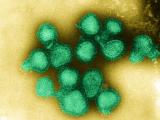The future of the flu vaccine may be in an adhesive strip no bigger than a Band-Aid, according to the results of a phase 1 clinical trial on a dissolvable microneedle patch conducted at Emory University and published yesterday in The Lancet.
Microneedle patches, small adhesives the thickness of paper studded with 100 short, thin needles, have been an underused avenue for delivering vaccines, said Nadine Rouphael, MD, associate professor of medicine at Emory and the lead author on the study, in an interview.
"They are more likely to be used in cosmetics. There has only been one prior study on their use for human vaccines, but it had no control group," she said. "This is the first time a single, disposable application that can be self-applied has been tested."
The results were promising: The microneedle patch, worn for 20 minutes on the wrist, elicited a robust immune response in study participants. Moreover, 70% of the participants who used the patch (33 of 47) said they preferred it to the injected flu vaccine.
"It was exciting to see their enthusiasm for the patch," Rouphael said. "It's painless." (Forty-eight of 50 volunteers, or 96%, rated it pain-free.)
To conduct the study, the researchers divided 100 adult volunteers into four groups; one got a traditional flu shot, one group received a placebo patch, another had the patch administered by a healthcare worker, and the final group applied the patch themselves. Twenty-eight days after the study, the geometric antibody mean titers were similar in all but the placebo group.
No refrigeration, easy disposal
The microneedle patch tested is stable for at least 1 year at 40°C (104°F), and the water-soluble needles dissolve, which means it generates little to no waste (the sticky part is discarded like a bandage).
Microneedle patches could also be manufactured at a similar rate to injected influenza vaccine, based on annual predictions of seasonal flu virus strains. The manufacturing cost of the patch would be competitive to prefilled syringes, the authors say.
"It's so easy to use, it could even be mailed to people," said Rouphael. "It's a simple technology, and it's cost-effective."
The National Institutes of Health funded the study, but Rouphael said it would be a few years before the patch could be manufactured. First, the patch needs to be tested on a larger group of adults. An upcoming study at Emory will test how well a pediatric group tolerates an inactive microneedle patch, and determine where the patch is best applied on children.
And, of course, the patch needs to demonstrate effectiveness in preventing influenza, not just in producing a strong immune response.
A commentary published alongside the study emphasized that many people avoid the influenza vaccine because of a fear of injections. More important, however, the ease of use and low cost to make the microneedle patch an attractive option for low-resource countries looking to integrate flu vaccine into national vaccination programs.
"Microneedle patches have the potential to become ideal candidates for vaccination programmes, not only in poorly resourced settings, but also for individuals who currently prefer not to get vaccinated, potentially even being an attractive vaccine for the paediatric population, provided late-stage clinical development confirms vaccine efficacy," concluded Katja Hoschler, PhD, and Maria C. Zambon, PhD, scientists with the National Infections Service of Public Health England.
See also:
Jun 27 Lancet study
Jun 27 Lancet commentary





















